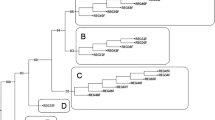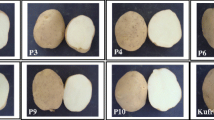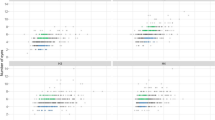Abstract
Twenty-one (near) pentaploid hybrids between sexually incompatible Solanum commersonii [2x(1EBN)] and cultivated S. tuberosum [4x(4EBN)] were characterized for tuber traits and fertility. A number of genotypes resembled the S. tuberosum type in terms of stolon length and eye depth and produced tubers under long day conditions. Tuber yields were not as high as expected, probably due to lack of adaptation of the S. commersonii genome to the environmental conditions in southern Italy (on average 325 g·pt−1 and 285 g·pt−1 in 2003 and in 2004, respectively). Compared to 2004, in the summer of 2003, characterized by extremely high temperatures, hybrids gave a higher tuber yield than the S. tuberosum control, suggesting that in our environmental conditions the wild S. commersonii genome, rather than resulting in heterosis for tuber yield, provides better adaptation to harsh environments. Although aneuploidy has often been associated with reduced fertility, several hybrids were fertile in crosses with S. tuberosum when used as female parents. In particular, the average berry set and number of seeds per berry were 38.2% and 31.8%, respectively. Based on significant relationships between ploidy levels and all yield and fertility data measured, the presence of extra chromosome affected the parameters considered: tuber yield in 2003 and 2004, percentage of fruit set, number of seeds per berry and number of seeds per pollinated flower. Regression analysis also indicated that “Residuals” were significant for all parameters measured. Therefore, additional factors (e.g. the genetic makeup of hybrids) may be key to fertility and yield.


Similar content being viewed by others
References
Bani-Ameur F, Lauer FI, Veilleux RE, Filali A (1991) Genomic composition of 4x–2x potato hybrids: influence of Solanum chacoense. Genome 34:413–420
Bradshaw JE, Bryan GJ, Ramsay G (2006) Genetic resources (including wild and cultivated Solanum species) and progress in their utilization in potato breeding. Potato Res 49:49–65
Camadro EL, Carputo D, Peloquin SJ (2004) Substitutes for genome differentiation in tuber-bearing Solanum: interspecific pollen–pistil incompatibility, nuclear-cytoplasmic male sterility and endosperm. Theor Appl Genet 109:1369–1376
Carputo D (2003) Cytological and breeding behaviour of pentaploids derived from 3x × 4x crosses in potato. Theor Appl Genet 106:883–888
Carputo D, Barone A, Cardi T, Sebastiano A, Frusciante L, Peloquin SJ (1997) Endosperm balance number manipulation for direct germplasm introgression to potato from a sexually isolated relative (Solanum commersonii Dun.). Proc Natl Acad Sci USA 94:12013–12017
Carputo D, Terra A, Barone A, Esposito F, Fogliano V, Monti L, Frusciante L (2003) Glycoalkaloids and acclimation capacity of hybrids between Solanum tuberosum and the incongruent hardy species Solanum commersonii. Theor Appl Genet 107:1187–1194
Carputo D, Castaldi L, Caruso I, Aversano R, Monti L, Frusciante L (2007) Resistance to frost and tuber soft rot in near-pentaploid Solanum tuberosum–S. commersonii hybrids. Breed Sci 57:145–151
Ehlenfeldt MK, Hanneman RE Jr (1988) Genetic control of endosperm balance number (EBN): three additive loci in a threshold-like system. Theor Appl Genet 75:825–832
Hanneman RE Jr, Bamberg JB (1986) Inventory of tuber-bearing Solonum species. Research Bullettin 533, University of Wisconsin, Madison, Wisconsin, p 216
Hijmans RJ, Spooner DM (2001) Geographic distribution of wild potato species. Amer J Bot 88:2101–2112
Iovene M, Barone A, Frusciante L, Monti L, Carputo D (2004) Selection for aneuploid potato hybrids combining a low wild genome content and resistance traits from Solanum commersonii. Theor Appl Genet 109:1139–1146
Jansky S (2000) Breeding for disease resistance in potato. Plant Breed Rev 19:69–155
Jansky S (2006) Overcoming hybridization barriers in potato. Plant Breed 125:1–12
Johnston SA, den Nijs TPM, Peloquin SJ, Hanneman RE Jr (1980) The significance of genic balance to endosperm development in interspecific crosses. Theor Appl Genet 57:5–9
Khush GS (1973) Transmission of extra chromosome in trisomics. In: Cytogenetics of aneuploids. Academic, New York, pp 60–86
Kratzke MG, Palta JP (1992) Variations in stolon length and in incidence of tuber roots among eight potato cultivars. Am Potato J 69:561–570
Laverty T, Vorsa N (1991) Fertility of aneuploids between the 5x and 6x levels in blueberry: the potential for gene transfer from 4x to 6x levels. J Am Soc Hort Sci 116:330–335
Lee HK, Kessel R, Rowen PR (1972) Multiple aneuploids from interspecific crosses in Solonum: fertility and cytology. Can J Genet Cytol 14:533–543
Lee KH, Namai H (1994) Cytogenetic and morphological characteristics of new types of diploids (2n = 22, 24, 40) derived from consecutive selfing of aneuploids in Brassica crops. Euphytica 72:15–22
Pavek JJ, Corsini DL (2001) Utilization of potato genetic resources in variety development. Am J Potato Res 78:433–441
Peloquin SJ, Boiteaux L, Carputo D (1999) Meiotic mutants in the potato—valuable variants. Genetics 153:1493–1499
Vorsa N, Jelenkovic G, Draper AD, Welker WV (1987) Fertility of 4x × 5x progenies derived from Vaccinium ashei/corymbosum pentaploid hybrids. J Am Soc Hort Sci 112(6):993–997
Acknowledgements
Contribution no. 161 from Dept. Soil, Plant, Environmental and Animal Production Sciences. The authors thank Mr. R. Garramone for his technical help.
Author information
Authors and Affiliations
Corresponding author
Rights and permissions
About this article
Cite this article
Caruso, I., Castaldi, L., Caruso, G. et al. Breeding potential of Solanum tuberosum–S. commersonii pentaploid hybrids: fertility studies and tuber evaluation. Euphytica 164, 357–363 (2008). https://doi.org/10.1007/s10681-008-9673-x
Received:
Accepted:
Published:
Issue Date:
DOI: https://doi.org/10.1007/s10681-008-9673-x




